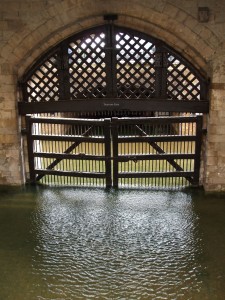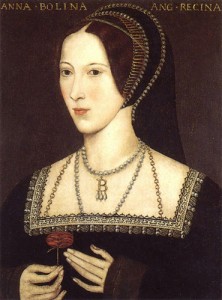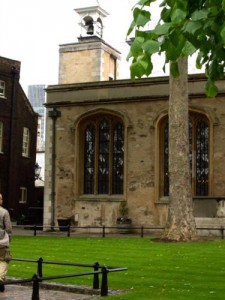
In today’s post I am going to continue the story of Sir Francis Weston, a man whose life was brutally cut short by Cromwell’s desperate need to rid himself of Anne Boleyn and her supporters.
Before I tell part 2 of Weston’s story, I’d like to share with you a discussion from the forum. Gina asked why Henry VIII chose to execute Weston, Norris and Brereton, who were all favourites of the King – click here to read the discussion. It is an interesting question particularly when we consider Henry’s deep friendship with Henry Norris and what I said last week about Henry supporting Francis Weston financially.
As Melissa answered on the forum, Anne Boleyn’s fall was actually a political coup against the Boleyn faction, of which those three men were prominent members. As much as I’d like to blame Henry VIII for Anne Boleyn’s fall, the coup was orchestrated by Thomas Cromwell who saw that he could kill three birds with one stone with his cunning plot – he could get rid of Anne, who was a threat and who was getting in the way of his plans, he would please the King by freeing him so that he could remarry and he could get rid of the annoying Boleyn faction at court. Cromwell also realised that any move against Anne needed to also get rid of her supporters, powerful men who could support Anne and stand against Cromwell and even cause Cromwell’s downfall. As Alison Weir writes in “The Lady in the Tower”:-
“Certainly, if Anne were to be removed, influential members of her faction would have to perish with her, to eliminate all opposition.”
Weston, Brereton, Norris and also Rochford and Smeaton were all men that could easily be implicated because they spent a lot of time with Anne and the courtly love tradition of the time meant that they flirted with Anne and she with them. How easy it was for Cromwell to twist this innocent banter into something more sinister! At the end of the day, these men were innocents who were in the wrong place at the wrong time and who had the wrong friends. Their relationships with Anne and the King had seen them rise at court and enjoy wonderful privileges and now those same relationships were bringing them down and ultimately causing their deaths. How fickle a King’s favour could be.
Sir Francis Weston – Arrest and Trial

On 3rd May 1536, Sir Francis Weston was interrogated by members of the King’s council. He vehemently denied the charges and protested his innocence but it made no difference and he was arrested the next day along with William Brereton and taken to the Tower.
While the men were imprisoned in separate rooms in the Tower, Anne’s attending ladies were reporting back to Sir William Kingston everything that Anne said as she struggled to come to terms with her imprisonment and tried to fathom out what she could have done to have these charges brought against her. In a letter to Cromwell, Kingston wrote that Anne had talked to Mrs Coffin, one of her attending ladies, of Weston and said that she had teased him “because he did love her kinswoman Mrs Shelton, and that she said he loved not his wife”. According to Anne, Weston then “made answer that he loved one in her house better than them both” and when Anne asked “Who is that?”, Weston replied “It is yourself”.
Now, that all sounds rather damning but as Weir, and other historians point out, this kind of talk was nothing more than courtly love. All Weston was doing was flattering the Queen, his mistress, after all, who could be more beautiful than the Queen? Shouldn’t every man in England be in love with the Queen? This banter was not meant to be taken literally, but this is what Cromwell did.
The Indictment
The part of the indictment against the five men which referred to Sir Francis Weston said:-
“Also the Queen, 8 May 26 Hen.VIII [1534], and at other times before and since, procured Sir Fras. Weston, of Westminster, one of the gentlemen of the King’s Privy Chamber, to have illicit intercourse with her, and that the Act was committed at Westminster 20 May 26 Hen. VIII [1534].”
A date of the 20th of June in Greenwich was also listed.
The indictment went on to say:-
“moreover, the said Lord Rochford, Norris, Brereton, Weston and Smeaton being thus inflamed with carnal love of the Queen, and having become very jealous of each other, gave her secret gifts and pledges while carrying on this illicit intercourse;”
The trouble with this indictment is that these dates just do not make any sense whatsoever. As Weir writes The illogicality in the charges strongly suggests that they were cobbled together in a hurry, without having been carefully scrutinised” and today the men’s lawyers would have got them off easily. Why? Because in Spring of 1534, when Anne was meant to have slept with Smeaton and Weston, she was actually visibly pregnant , plus she was nowhere near Westminster on 20th May and Greenwich on 20th June, she was with the King at Richmond and then Hampton Court Palace. These facts seemed to have been glossed over, unless it was thought that Anne, being a witch, could be in two places at once!
The Trial
Despite both Anne and four of the men protesting their innocence, trials were ordered and arranged. As commoners, Weston, Brereton and Norris were tried separately to Anne and her brother, who had the right to be tried and judged by their peers. The four men were taken by barge from the Tower of London to Westminster Hall to be brought before special sessions of oyer and terminer. At Westminster, Sir William Kingston brought all four to the bar and they were arraigned for high treason.
It is a shame that the official court records are missing from the records of Henry VIII’s reign (hmmm, slightly suspicious?) and all we can go on are accounts from people who witnesses the trial and rumours from the time. We do know, however, that the men were charged “that they had violated and had carnal knowledge of the Queen, each by himself at separate times” and also with conspiring the King’s death with Anne. Out of the four, only Mark Smeaton pleaded guilty and there are no accounts of any witness testimonies.
At the end of the trial, the jury was unanimous in finding all four men guilty. The Chief Commissioner, Lord Chancellor Audley, read out the sentence that applied to all four men, that they should be “hanged, drawn and quartered, their members cut off and burnt before them, their heads cut off and quartered.” This was the normal punishment for traitors.
End Times
Alison Weir writes of how there was much public sorrow for the men when news of their sentence got out. It seems that Weston and Norris particularly were widely respected and liked by the court and public. As Lancelot de Carles wrote:-
“Everyone was moved at their misfortune, especially at the case of Weston.”
Weir also writes of how there is much evidence to show that Weston’s family did all they could to try and save him. Lancelot de Carles reported:-
“no one dared plead for him [Weston]except his mother, who, oppressed with grief, petitioned the King, and his wife [Weston’s wife], who offered rents and goods for his deliverance”.
We also know that Sir Richard Weston and the family sought to obtain an audience with the King or a meeting with Cromwell to beg for Weston’s life. According to the Letters and Papers, Foreign and Domestic, of the Reign of King Henry VIII, Weston’s family offered the King 100,000 marks (over £11 million) if he would spare Sir Francis. Weir points out that Henry VIII must have been either very determined to get rid of Weston or he was not told of this offer. Eric Ives points out that the crown would not profit from Weston’s death, seeing as his parents were still alive, so it could well be that the King was not told of the offer from Weston’s family because he may have chosen to take it. Would he really turn down this chance to profit?
Weston’s family were not the only ones to take up his cause. Chapuys, the Imperial Ambassador, reported that the French Ambassadors, Antoine de Castelnau (Bishop of Tarbes) and Jean, Sieur de Dinteville, did their best to plead for Weston’s life. However, none of these pleas were successful although Kingston did hear late on 16th May or early on 17th that the men’s sentences had been commuted to the more merciful execution by decapitation.
Weir writes of how Sir Francis Weston spent his last night writing out his list of debts which are testimony to his lavish lifestyle, his importance at court and his favour with the King and Queen. His list of debts and creditors included:-
- the King – 2 amounts of 40s. (£700) and 50 marks (£4,050)
- His father
- His father’s cook, Barnarde
- his cousin Dingley
- Thomas Boleyn, father of Anne and George
- Browne, the draper
- Jennings, a page of the Privy Chamber
- 3 “broderers” (embroiderers) – Weston owed one of them £35 (£12,200) for a gown, a coat and a gold cloth doublet which shows what royal favour he enjoyed because sumptuary laws only allowed those of the rank of earl or above to wear embroidered clothing and cloth of gold was only worn by dukes, marquesses and monarchs.
- The King’s goldsmith, Cornelius Heyss – Another example of Weston’s status and favour.
- Peter the hosier
- Bridges, his tailor
- A woman for tennis balls
- Harde Derman “at the gate”
- Henry Seymour, a brother of Jane Seymour
- Sir Francis Bryan
- Sir Henry Parker, brother of Jane Rochford who was married to George Boleyn
- A page at court
and many more.
What is amazing is the total owing – £925.7s.2d (£323, 150)! As Weir points out, this was a huge amount and one which could easily ruin his remaining family.
This list of debts and names was enclosed with a farewell letter of apology to his parents:
“Father and Mother,
I shall humbly desire you, for the salvation of my soul, to discharge me of this bill, and to forgive me of all my offences that I have done to you, and in especial to my wife, which I desire for the love of God to forgive me and to pray for me, for I believe prayer will do me good. God’s blessing have my children and mine.
By me, a great offender to God.”
This letter is not to be taken as a confession of guilt but more an apology for his debts and acknowledgement that he, like all men, was a sinner.
Death
On Wednesday 17th May 1536, the five men were led out to the scaffold on Tower Hill at the Tower of London. Weston was the third to be executed, after George Boleyn and Henry Norris, and before kneeling at the block, which would have been soaked with his friends’ blood, he said:-
“I had thought to live in abomination yet this twenty or thirty years, and then to have made amends, I thought little I would come to this.”
Weston also commented that the crowd should learn “by example of him”.

So, what is the “abomination” that Weston is referring to? Well, if you believe Retha Warnick’s views on these men then you will conclude that Weston is referring to buggery but it could mean anything. Weir writes of how it could possibly mean “illicit sexual acts” but I think it was just referring to the belief that we are all guilty, we are all sinners because of original sin. Sin is an abomination and I think that Weston was probably just referring to his sinful life and not a particular sin like committing adultery or having sexual intercourse with a man.
After the executions were finished, Sir Francis Weston’s body was laid to rest in the same grave as Sir Henry Norris in the graveyard of the Chapel of St Peter ad Vincula, an area which is now covered by the Tower’s Jewel House and the Waterloo Barracks. When these buildings were built, all of the bones were re-interred in the Chapel crypt so Weston’s remains are now in the Chapel somewhere.
Weston’s widow, Anne Weston, went on to marry Sir Henry Knyvett, a gentleman of the Privy Chamber, quite quickly after her husband’s death. Sir Henry had helped her in her fight for her husband’s life, so the two probably became close then. Anne and Henry Knyvett had six children together before Henry died in 1547. Anne then went on to marry a third time, marrying a man named John Vaughn. Anne died in 1582 and must have been a good age seeing as Sir Francis was only in his 20s when he died in 1536. Weir writes of how her son by Weston was not restored in blood until 1549, thirteen years after Weston was executed as a traitor.
Sir Francis Weston in Fiction
While I was researching Sir Francis Weston and his home, Sutton Place, I came across http://www.derynlake.com/sutton.php, which is the website of author Deryn Lake who has written some historical novels under the name of Dinah Lampitt. On the website it has this to say about her book “Sutton Place”:-
“A well is poisoned by a young queen’s curse. The beautiful mansion of Sutton Place was cursed by Queen Edith five centuries before its builder was born. Now Sir Richard Weston’s family must pay the price of evil that is exacted from all the Tudor manor’s owners.
Sir Richard’s son will die beneath an executioner’s blade, his death warrant signed by Henry VIII. Anne Boleyn too will feel the scourge of destiny as she struggles for the Queen’s crown. And centuries later, press baron Lord Northcliffe and oil millionaire Paul Getty will also succumb to the darkness that envelopes all those who own the doomed manor of Sutton…
Sutton Place is the first haunting volume of Dinah Lampitt’s fascinating trilogy tracing the tortured destinies of those who dared to flout the young Queen’s curse. “Deliciously spook-ridden” The Daily Telegraph”
I can’t comment on the novel because I haven’t read it but it sounds intriguing! The book is currently out of print but if you see it on a secondhand book stall then it might be worth buying. Check your local library too.
Sources
- “The Lady in the Tower” by Alison Weir
- “The Life and Death of Anne Boleyn” by Eric Ives
- “The Rise and Fall of Anne Boleyn” by Retha Warnicke
- Letters and Papers, Foreign and Domestic, Henry VIII
Photos by Paudie Kennelly – click here to see a YouTube montage of his wonderful Tower of London photos.
Halloween Competition
Remember to send in photos of your Halloween costumes – see Halloween Competition for rules and details.